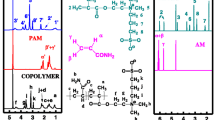Abstract
In this paper, we have investigated the lower critical solution temperature (LCST) of N-isopropylacrylamide–acrylic acid (NIPAAm-AAc) copolymer as a function of chain-transfer agent/initiator mole ratio, acrylic acid content of copolymer, concentration, pH and ionic strength of aqueous copolymer solution. Aqueous solutions with the desired properties were prepared from previously purified polymers, synthesized at 65 °C by solution polymerization using ethanol. The effects of each parameter on the LCST were examined experimentally.In addition, an artificial neural network model that is able to predict the lower cretical solution temperature was develeped. The predictions from this model compare well against both training and test data sets with an average error less than 2.53%.
Figure Cross plot of predicted and experimental LCST values for the testing data set.











Similar content being viewed by others
References
Heskins M, Guillet JE (1968) J Macromol Sci Chem 2:1441–1455
Chiklis CK, Grasshoff JM (1970) J Polym Sci A; Polym Chem 8:1617–1626
Kujawa P, Winnik FM (2001) Macromolecules 43:4130–4135
Elkamel A, Abdul-Wahab S, Bouhamra W, Alper E (2001) Adv Environ Res 5:47–59
Baughman DR, Liu YA (1990) Neural networks in bioprocessing and chemical engineering. Academic, New York
Agatonovic-Kustrin S, Beresford R (2000) J Pharm Biomed Anal 22:717–727
Pollard JF, Broussard MR, Garrison DB, San KY (1992) Comput Chem Eng 16:253–270
Churchland PS, Sejnowski TJ (1992) The computational brain. MIT Press, Cambridge
Schalkoff RJ (1997) Artificial neural networks. McGraw-Hill, New York
Basheer IA, Hajmeer M (2000) J Microbiol Methods 43:3–31
Elkamel A, Kargoub M, Gharbi R (1996) Comp Chem Eng 20:515–520
Quantrille TE, Liu YA (1991) Artificial intelligence in chemical engineering. Academic, New York
Haykin S (1999) Neural networks: a comprehensive foundation. Prentice Hall, Englewoodcliffs
Swingler K (1996) Applying neural networks: a practical guide. Academic, New York
Kratz K, Hellweg T, Eimer W (2000) Colloids Surf, A 170:137–149
Hagan MT, Menhaj M (1994) IEEE Trans Neural Netw 5:989–993
Demuth H, Beale M (2003) Neural network toolbox for use with matlab. The Mathworks Inc
Acknowledgements
This work was supported by The Scientific and Technical Research Council of Turkey (TÜB İ TAK, MISAG-242).
Author information
Authors and Affiliations
Corresponding author
Rights and permissions
About this article
Cite this article
Kayı, H., Tuncel, S.A., Elkamel, A. et al. Prediction of lower critical solution temperature of N-isopropylacrylamide–acrylic acid copolymer by an artificial neural network model. J Mol Model 11, 55–60 (2005). https://doi.org/10.1007/s00894-004-0221-x
Received:
Accepted:
Published:
Issue Date:
DOI: https://doi.org/10.1007/s00894-004-0221-x




